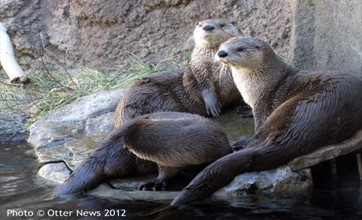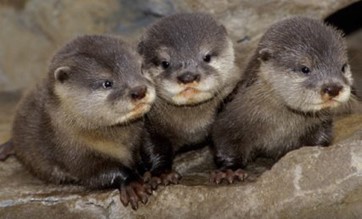Fast Facts: River Otter
Description
The North American River Otter, Lontra canadensis, is a water-loving mammal well-adapted to life on land and in the water. It is thin and sleek, reaching 38-47 inches in length and weights of approximately 10-20 pounds. The River Otter’s coat consists of short, thick dark brown fur on the back that turns to a reddish yellow color on the stomach. It uses its webbed feet and thick tail to propel rapidly (up to 7 miles per hour) through the water, but can move even faster on land – up to 18 mph. River Otters can stay submerged for up to eight minutes, closing their nostrils and ears to keep water out, and reach depths of 60 feet. Sexual maturity is between 2 and 3 years of age, with mating occurring from December to April. The gestation period is 60-63 days and litter size is 2 to 5 pups. Average life expectancy in the wild is 16 years.

Habitat
River Otters prefer the fresh water of rivers, creeks, ponds, lakes and swamps but can be found in coastal salt marshes like those around the FSU Coastal & Marine Lab. They live in dens called holts that are dug into a riverbank or under the roots of trees. A typical holt has a main underwater entrance, leading to a space above the water that has several holes to allow air flow. Baby otters, called kits, are usually born in these dens in the spring and remain there for several months.
Behavior & Diet
River Otters feed nocturnally on insects, crustaceans, fish, amphibians, reptiles, and birds, relying on their very keen eyesight, hearing, and smell to detect their prey. Sensitive whiskers help even more to find food on the riverbed. The extraordinary effort extended on playing with their food -- wrestling, chasing, playing catch and release -- serves to enhance their hunting skills. While playing or grooming, they tend to make chirping and grunting sounds while during mating or fighting, they elicit high-pitched squeals that can be heard over a mile away.

Conservation
The primary threats to River Otters are habitat loss and pollution, especially related to the bioaccumulation of mercury and organochloride compounds. Because of this sensitivity and their position as top level predators, scientists use them as bioindicators of problems in aquatic ecosystems. Protecting water quality and habitat are primary roads to protecting River Otter populations. To learn more about protecting our water resources go to http://www.protectingourwater.org.

